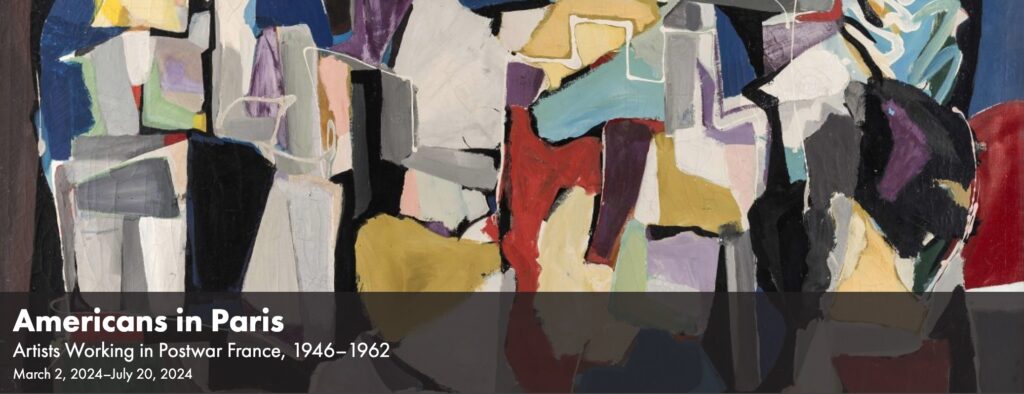Americans in Paris: Artists Working in Postwar France, 1946–1962
International touring schedule:
- March 2–July 20, 2024 | Grey Art Gallery, New York University, 18 Cooper Square, New York, NY 10003
- September 3, 2024–January 5, 2025 | Addison Gallery of American Art, Phillips Academy, Andover, Massachusetts
- February 11–June 1, 2025 | The NYU Abu Dhabi Art Gallery, United Arab Emirates
Americans in Paris: Artists Working in Postwar France, 1946–1962 is the first major exhibition to examine the historical impact of the expatriate art scene in Paris after World War II, and delves into the various circles of artists who made France their home during an era of intense geopolitical realignment. This international loan exhibition showcases more than 130 works by approximately 70 artists, providing a fresh perspective on a moment of creative ferment too often overshadowed by the contemporaneous ascendancy of the New York City art scene.
The exhibition covers a 17-year period beginning in 1946, when the U.S. Embassy in Paris began processing applications from ex-service members for the new GI Bill. A monthly stipend of $75 allowed many artists, such as Norman Bluhm, Ed Clark, Sam Francis, Al Held, Ellsworth Kelly, Kenneth Noland, and Jack Youngerman, along with many whose work has not received the recognition it merits, such as Robert Breer, Harold Cousins, and Shinkichi Tajiri, to opt for a foreign rather than a domestic learning experience. Seasoned artists, such as Beauford Delaney, Claire Falkenstein, Carmen Herrera, Joan Mitchell, Kimber Smith, and Mark Tobey, like the GIs, were drawn to the storied modernist traditions that still flowed from this fabled City of Light. Intense experimentation among these closely knit, if shifting, circles of artists generated a variety of formal inventions and personal artistic styles. Because a good number of the works on view come from early in the artists’ careers, Americans in Paris contributes to the understanding of the development of many of the featured artists—dramatically so in the case of the abstract paintings by William Klein, works that preceded his experiments in photography and his later success as an art and commercial photographer and a filmmaker.
While the first section of Americans in Paris focuses on 25 American artists who lived and worked in France for a year or more, the second section—the “Salon”—provides visitors with a snapshot of art that the expats themselves would have encountered in the influential salons and galleries of postwar Paris. Americans in Paris investigates the academies where many of these artists studied, the spaces where their work was exhibited, the aesthetic discourses that animated their conversations, their interactions with European artists, and the overarching issue of what it meant to be an American abroad. The exhibition also sheds new light on the contributions of artists who relocated to France hoping to escape institutionalized racism, sexism, and homophobia. At the same time, the Americans encountered undercurrents of nationalistic tension, as French artists and critics sought to maintain the centuries-long artistic preeminence of the City of Light. By 1962—when the show concludes—many artists felt that the once-inspiring atmosphere in Paris had diminished. That same year, Algeria achieved independence from France after many years of demonstrations and riots, and ultimately, war. By then, many Americans had decided to return to the U.S., which was experiencing a burgeoning Civil Rights movement of its own, along with—due to the rise of artist-run galleries in New York—more opportunities to exhibit.
Six years in the making, Americans in Paris is curated by the independent scholar Debra Bricker Balken with Lynn Gumpert, and is accompanied by a 300-page illustrated publication.
Leo Zimmerman’s painting in the show:
Leo Zimmerman
PUBLICATION
Americans in Paris: Artists Working in Postwar France, 1946-1962
The first substantial, scholarly overview of the American creative community living in postwar Paris, featuring never-before-published interviews with Americans and French artists, critics, and dealers. This book delves into the various circles of artists who lived in France following World War II. Featuring new scholarship and illuminating essays, the groundbreaking volume illustrates many of the paintings, sculptures, drawings, prints, photos, and films produced between 1946 and 1962. Americans in Paris introduces the story of the American creative community that inhabited the City of Lights following the Second World War.
